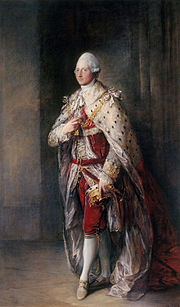Prince Henry, Duke of Cumberland and Strathearn (Henry Frederick;[1] 7 November 1745 – 18 September 1790) was the sixth child and fourth son of Frederick, Prince of Wales and Augusta of Saxe-Gotha, and a younger brother of George III. His 1771 marriage to a commoner against the King's wishes prompted the Royal Marriages Act of 1772 .
Early life[]

Henry (right) with his brother William Henry, from a family group portrait of 1751.

Prince Henry, aged 9, by Liotard
Prince Henry of Wales was born on 7 November 1745 at Leicester House, London to Frederick, Prince of Wales, son of George II and Caroline of Ansbach, and his wife The Princess of Wales. He was christened at Leicester House twenty-three days later.[2]
Royal Dukedom[]

Equestrian portrait by David Morier around 1765
On 22 October 1766,[3] just prior to his twenty-first birthday, the prince was created Duke of Cumberland and Strathearn and Earl of Dublin.
Allegations[]
On 4 March 1767, the Duke of Cumberland allegedly married Olive Wilmot (later Mrs Payne), a commoner, in a secret ceremony. There reportedly was one child, Olivia Wilmot (1772–1834), from this relationship, though the duke's paternity was never proven, and Olivia Wilmot was accused of forging the evidence. A landscape painter and novelist, Olivia Wilmot married John Thomas Serres (1759–1825) and later, controversially, assumed the title of "Princess Olivia of Cumberland".
In 1769, the Duke of Cumberland was sued by Lord Grosvenor for "criminal conversation" (that is, adultery) after the Duke and Lady Grosvenor were discovered in flagrante delicto.[4] Lord Grosvenor was awarded damages of £10,000, which together with costs amounted to an award of £13,000 (equivalent to £1,610,000 in 2024).[5]
[]
In 1768, at the fairly late age of 22, the Duke entered the Royal Navy as a midshipman and was sent to Corsica in HMS Venus. However, he returned in September when the ship was recalled following the French invasion of the Corsican Republic. He was promoted to Rear-Admiral the following year and Vice-Admiral in 1770.[6]
Marriage[]
On 2 October 1771 the Duke married Anne Horton (1743–1808), daughter of Simon Luttrell, 1st Earl of Carhampton, and the widow of Christopher Horton of Catton Hall. This marriage to a commoner caused a rift with the King and was the catalyst for the Royal Marriages Act 1772, which forbade any descendant of George II to marry without the monarch's permission. There were no children from this marriage. The marriage between Anne Horton and the Duke of Cumberland was described as a "conquest at Brighthelmstone" (now Brighton) by Mrs. Horton, "who", Horace Walpole says, "had for many months been dallying with his passion, till she had fixed him to more serious views than he had intended."[7] Anne was however generally thought one of the great beauties of the age, and Thomas Gainsborough painted her several times.
Later life[]
In 1775, the Duke established the Cumberland Fleet, which would later become the Royal Thames Yacht Club. He was promoted vice-admiral of the White in 1776,[8] admiral of the Blue in 1778,[9] and admiral of the White in 1782,[10] though he was forbidden from assuming any command. The Duke was also instrumental in the development of Brighton as a popular resort. He had first visited in 1771, and in 1783, the Prince of Wales visited his uncle there.[6]
The Duke of Cumberland died in London on 18 September 1790. His widow died in 1808.
Titles, styles, honours and arms[]
Titles[]
- 7 November 1745 – 22 October 1766: His Royal Highness Prince Henry[1]
- 22 October 1766 – 18 September 1790: His Royal Highness The Duke of Cumberland and Strathearn
The prince's full style, as recited by Garter King of Arms at his funeral, was the "Most High, Most Mighty and Illustrious Prince Henry Frederick, Duke of Cumberland and Strathearn, Earl of Dublin, Knight of the Most Noble Order of the Garter".[11]
Arms[]
File:HenryCumberlandStrathearnArms.png
Henry was granted use of the arms of the kingdom, differenced by a label argent of five points, the centre bearing a cross gules, the other points each bearing a fleur-de-lys azure.[12]
Ancestors[]
| Ancestors of Prince Henry, Duke of Cumberland and Strathearn | ||||||||||||||||||||||||||||||||||||||||||||||||||||||||||||||||||||||||||||||||||||||||||||||||||||||||||||||||||||||||||||||||||||||||||||||||||||||||||||||||||||||||||||||||||||||||||||||||||||||||||||||||||||||||||||||||||||||||||||||||||||||||||||||||||||||||||||||||||||||||||||||||||||||||||||||||||||||||||||||||||||||||||||||||||||||||||||||||||||||||||||||||||||||||||||||||||||||||||||||||||||||||||||||||||||||||||||||||||||||||||||||||||||||||||||||||||||||||||||||||||||||||||||||||||||||||||||||||||
|---|---|---|---|---|---|---|---|---|---|---|---|---|---|---|---|---|---|---|---|---|---|---|---|---|---|---|---|---|---|---|---|---|---|---|---|---|---|---|---|---|---|---|---|---|---|---|---|---|---|---|---|---|---|---|---|---|---|---|---|---|---|---|---|---|---|---|---|---|---|---|---|---|---|---|---|---|---|---|---|---|---|---|---|---|---|---|---|---|---|---|---|---|---|---|---|---|---|---|---|---|---|---|---|---|---|---|---|---|---|---|---|---|---|---|---|---|---|---|---|---|---|---|---|---|---|---|---|---|---|---|---|---|---|---|---|---|---|---|---|---|---|---|---|---|---|---|---|---|---|---|---|---|---|---|---|---|---|---|---|---|---|---|---|---|---|---|---|---|---|---|---|---|---|---|---|---|---|---|---|---|---|---|---|---|---|---|---|---|---|---|---|---|---|---|---|---|---|---|---|---|---|---|---|---|---|---|---|---|---|---|---|---|---|---|---|---|---|---|---|---|---|---|---|---|---|---|---|---|---|---|---|---|---|---|---|---|---|---|---|---|---|---|---|---|---|---|---|---|---|---|---|---|---|---|---|---|---|---|---|---|---|---|---|---|---|---|---|---|---|---|---|---|---|---|---|---|---|---|---|---|---|---|---|---|---|---|---|---|---|---|---|---|---|---|---|---|---|---|---|---|---|---|---|---|---|---|---|---|---|---|---|---|---|---|---|---|---|---|---|---|---|---|---|---|---|---|---|---|---|---|---|---|---|---|---|---|---|---|---|---|---|---|---|---|---|---|---|---|---|---|---|---|---|---|---|---|---|---|---|---|---|---|---|---|---|---|---|---|---|---|---|---|---|---|---|---|---|---|---|---|---|---|---|---|---|---|---|---|---|---|---|---|---|---|---|---|---|---|---|---|---|---|---|---|---|---|---|---|---|---|---|---|---|---|---|---|---|---|---|---|---|---|---|---|---|---|---|---|---|---|---|---|---|---|---|---|---|---|---|---|---|---|---|---|---|---|---|---|---|---|---|---|---|---|---|---|---|---|---|---|---|---|---|---|---|---|---|---|---|---|---|---|---|---|---|---|---|---|---|---|---|---|---|---|---|---|---|---|---|---|---|---|---|---|---|---|---|---|---|---|---|---|---|---|---|---|---|---|---|---|---|---|---|---|
| ||||||||||||||||||||||||||||||||||||||||||||||||||||||||||||||||||||||||||||||||||||||||||||||||||||||||||||||||||||||||||||||||||||||||||||||||||||||||||||||||||||||||||||||||||||||||||||||||||||||||||||||||||||||||||||||||||||||||||||||||||||||||||||||||||||||||||||||||||||||||||||||||||||||||||||||||||||||||||||||||||||||||||||||||||||||||||||||||||||||||||||||||||||||||||||||||||||||||||||||||||||||||||||||||||||||||||||||||||||||||||||||||||||||||||||||||||||||||||||||||||||||||||||||||||||||||||||||||||
References[]
Citations[]
- ↑ 1.0 1.1 He is called simply "(His Royal Highness) Prince Henry" in the London Gazette 8 September 1761; 25 May; 28 December 1765; 14 December 1771
- ↑ Yvonne's Royalty Home Page: Royal Christenings
- ↑ Yvonne's Royalty: Peerage
- ↑ Stella Tillyard (2010). A Royal Affair: George III and His Troublesome Siblings. Random House. pp. 169–175. ISBN 1-4090-1769-9.
- ↑ UK CPI inflation numbers based on data available from Gregory Clark (2013), "What Were the British Earnings and Prices Then? (New Series)" MeasuringWorth.
- ↑ 6.0 6.1 The Oxford Dictionary of National Biography
- ↑ Walpole, Horace. Memoirs and Portraits, 244.
- ↑ "No. 11637". 3–6 February 1776. p. 1. https://www.thegazette.co.uk/London/issue/11637/page/1
- ↑ "No. 11844". 27–31 January 1778. p. 2. https://www.thegazette.co.uk/London/issue/11844/page/2
- ↑ "No. 12286". 9–13 April 1782. p. 2. https://www.thegazette.co.uk/London/issue/12286/page/2
- ↑ "No. 13241". 2 October 1790. p. 598. https://www.thegazette.co.uk/London/issue/13241/page/598
- ↑ Marks of Cadency in the British Royal Family
External links[]
The original article can be found at Prince Henry, Duke of Cumberland and Strathearn and the edit history here.
